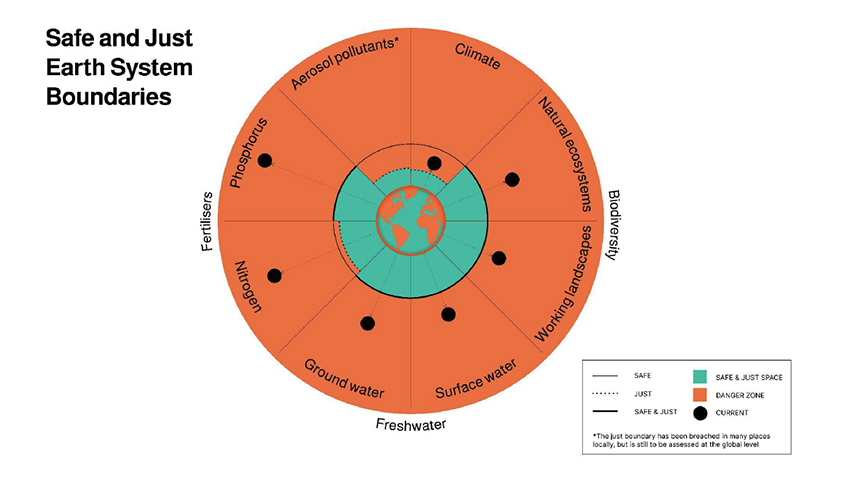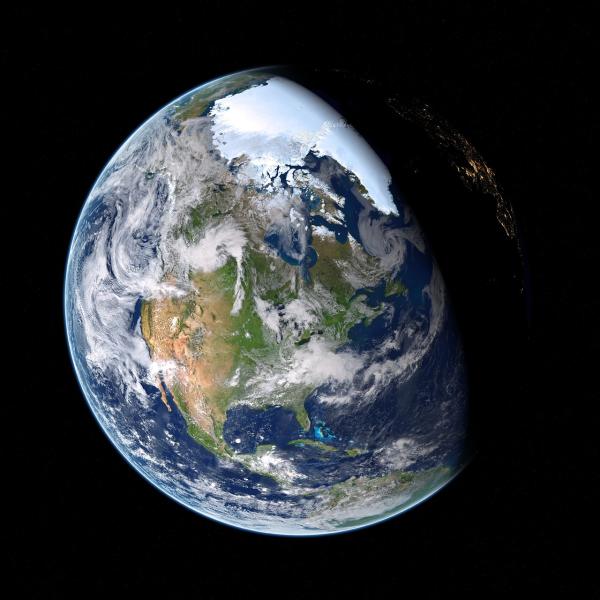Biosphere
“Our Biosphere includes people and all other living organisms that we directly or indirectly interact with. The Biosphere is our common heritage that sustains human existence.”
In short, the Biosphere is our world which, for the sake of this analysis, has been neatly divided into “largely intact natural ecosystems,” the wild, and “human-dominated ecosystems,” our built world, including the lands we use for resources, like farmland or parks.
The need to maintain large swaths of the planet in its “natural” state is based on climate, water, and species conservation models. The experts place that value for a safe boundary at 50-60% of the global land surface to “maintain Earth system NCP [nature’s contribution to people].”
Of course, those boundaries are subject to many caveats because those natural areas must provide “specific ecological functions,” which depend on how we define their value.
“Biome-scale boundaries may be more stringent: for example, to protect tropical forest biomes due to their contribution to climate stability and moisture recycling.”
Then there is that messy issue of justice. Restoring and maintaining largely intact natural ecosystems is complicated because they are unevenly distributed, especially those “needed to support local livelihoods, especially in poor or Indigenous communities.” While justice for future generations seems assured, the adjustments necessary now may mean that ...
“Some people and countries may directly benefit from policies to maintain or increase natural ecosystem area, while others may face opportunity costs.”
Human-dominated systems require a “functional integrity” – providing and “complementing the Earth system [nature’s contribution to people],” in brief, all that makes life livable. [1] To that end, 20-25% of our human-modified lands require a semi-natural habitat. [2] And while these measures will reduce harm to future generations, the impact on current generations is mixed.
“Specific interventions that secure functional integrity are highly local and are best implemented under local authority, knowledge and leadership, with policy interventions often needed to ensure that marginalized groups are not further disempowered but are given the space to use their knowledge and approaches to participate in such processes.”
Aerosol Pollution
“Aerosols from natural sources dominate air pollution concentration in wild areas but anthropogenic (human-made) sources are prevalent in areas where most people live.”
Aerosols are tiny particles suspended in the upper atmosphere. Part of the reason that aerosols are the chosen metric is that we can measure them using optical technology (aerosol optical depth) aboard satellites and get the bigger picture. The Northern hemisphere has a greater land mass and population than the Southern, “thus more polluting activities.” Based on volcanic eruptions [3] and modeling, it is felt that ...
"this could lead potentially to an imbalance of aerosol concentrations between the two hemispheres, which can potentially disrupt rain patterns, such as the monsoon system.”
In this instance, the safe boundary is not necessarily a clear line; more fuzzy and unclear.
For the Weird (Western, Educated, Industrialized, Rich, and Democratic), the aerosol of most significant concern is exposure to particulate matter, PM2.5.
“The just boundary is set at 15 μg/m3 mean annual exposure to PM2.5 to avoid a high likelihood of significant harm from aerosols.”
While the researchers acknowledge an association between PM2.5 and health concerns and estimate that 85% of the global population is exposed to higher levels, they write that to achieve a more just boundary; it is necessary to consider “local air pollution standards.” They set the boundary at 15 μg/m3 mean annual exposure; the current U.S. standard that many “activists” wish to lower further is 12 μg/m3.
Final thoughts

Overall, I found the article thoughtful, especially in developing the scientific “basis” for their conclusions. There is a species-centric bias in their calculation, but as a member of the prioritized species, I am OK with that. To my mind, the greatest failure is in creating just action plans. While I am satisfied with their definitions of justice, for one and all, for now, and the future, how to achieve that justice is at best problematic and at worst impossible.
I return to the warning of John List in The Voltage Effect, applications that require human intelligence are challenging to scale, requiring “political will” faithful to the plan. I have grave doubts that our leadership, more interested in maintaining their status and catering to their supporters, will not have the political will to move us towards reasonable environmental goals.
The authors have done their job in presenting a framework based on our best current scientific understanding. Whether we as global citizens, along with our elected representatives, will take up their challenge, or allow it to be captured by special interests on either side of the debate, is the first of many hurdles we face in attempting to guarantee the safety of our home. I will leave you with the prophetic words of stand-up comedian George Carlin from 30 years ago.[4]
“I mean, to be fair, the planet probably sees us as a mild threat; something to be dealt with, and I’m sure the planet will defend itself in the manner of a large organism. Like a beehive or an ant colony can muster a defense, I’m sure the planet will think of something. What would you do if you were the planet trying to defend against this pesky, troublesome species? Let’s see … what might … hmm … viruses! Viruses might be good. They seem vulnerable to viruses. And uh … viruses are tricky; always mutating and forming new strains whenever a vaccine is developed.”
[1] Including “pollination, pest and disease control, water quality regulation, soil protection, natural hazards mitigation and recreation.”
[2] Search as I might, the article did not define semi-natural, leaving another ambiguity. Is Central Park semi-natural? Its landscape, all man-made, required 5 million cubic yards of stone, earth, and topsoil and 500,000 trees, shrubs, and vines.
[3] While volcanic eruptions can be quite dramatic and release significant quantities of aerosols in moments, they are relatively infrequent compared to the much lower-level amounts of aerosols generated by human activity daily. The eruption of Tambora in 1815 led to three years of cooling temperatures, weather disruption, and significant human suffering. That said, net humans contribute more.
[4] At that moment, he was speaking about HIV, although COVID is a close match.
Here are the other parts of the article:
Part I – Earth System Boundaries – the science
Part II – Earth System Boundaries, the methodologies of “Justice”
Part III – Earth System Boundaries, Climate, water, nutrients
Source: Safe and Just Earth System Boundaries Nature DOI: 10.1038/s41586-023-06083-8




